Soft Sourdough Sandwich Bread
This post may contain affiliate links. Please read our disclosure policy.My family loves soft white sourdough sandwich bread. Pillowy soft, tender and light, this sourdough white sandwich bread is incredible with just a slight tang from the sourdough. We use it for sandwiches, french toast, making breadcrumbs, etc., and we love adding cinnamon chips or cheese. It’s so versatile and delicious. I’ve spent months working on perfecting this bread and it’s finally delicious every time I make it, which is almost weekly around here. This is 100% natural yeast sandwich bread and I know you will love it too.

Sample Soft Sourdough Sandwich Bread Baking Schedule
This sample baking schedule is what works for me. I’m up early getting kids off to school and can mix up some levain in the morning while they eat breakfast. I mix the dough throughout the day and bake the bread around dinner time. Who doesn’t love a nice hunk of warm bread with their dinner?! I’ll slice it in the evening to use for sandwiches and toast throughout the week. Your schedule could definitely look different than mine, and that’s okay – do what works for you. A more detailed explanation of each step is further down in this post.
| 7:00 AM – 10:00 AM | Mix Levain. Cover and ferment for about 3 hours until doubled in size, bubbly and ripe. |
| 10:00 AM | Knead dough in a stand mixer for 10-15 minutes until smooth and passes windowpane test |
| 10:15 AM – 11:45 AM | Begin Bulk Fermentation Rest 30 minutes Stretch and fold the dough every 30 minutes, 3 times total |
| 11:45AM – 2:00 PM | Continue Bulk Fermentation Optional: After the bulk fermentation, the dough can be covered and stuck in the refrigerator until the next morning. Allow extra time for rising if you choose this option. |
| 2:00 PM | Divide and shape. Proof in a warm place (78-90 degrees F) The temperature you choose will determine how quickly your loaves will rise. |
| 6:00 PM – 10:00 PM | Bake: ONLY once the dough has doubled in size and risen above the loaf pan. This can take a long time, depending a lot on temperature and how active your sourdough starter is. If the dough is too cold, it won’t rise quickly – move it to a warmer location and wait for the bread to rise. Don’t bake the bread until it has properly risen. |

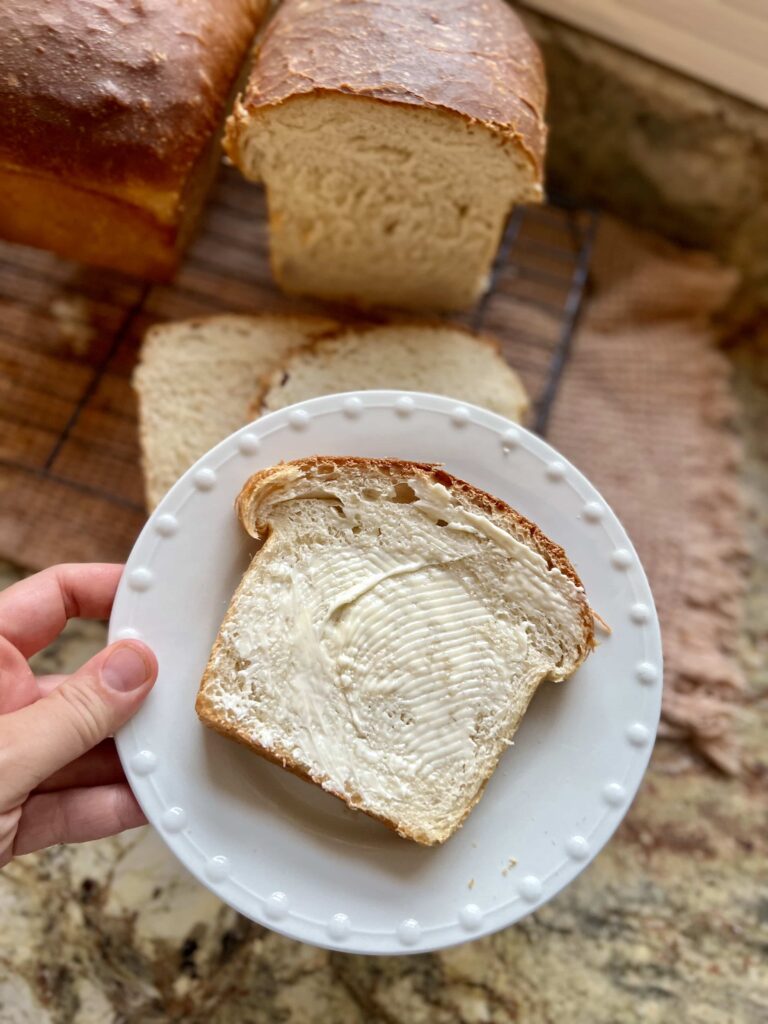

Ingredients in Soft Sourdough Sandwich Bread
- Levain: A mixture made from your active sourdough starter. This will cause the bread to rise.
- Honey: Honey adds a sweetness to the dough. You could also substitute sugar.
- Coconut Oil: I love the soft texture coconut oil gives the dough. You can add cold or liquid coconut oil to the mixing bowl. The heat from the mixing will help the coconut oil absorb fully into the bread dough. You can substitute any neutral flavored oil.
- Egg: One large egg is about 50 grams. This recipe makes two loaves of bread; if you want to make one loaf instead, mix up the egg in a bowl and then use 25 grams in the recipe.
- Water: Depending on the temperature of the other ingredients and the temperature inside your kitchen, you’ll want to use either cool, warm or room temperature water. This strongly influences how well your dough will rise (especially in the winter).
- Salt: Salt enhances flavor. Don’t forget to add it!
- Bread Flour: I use a good quality bread flour that I buy from my local mill. It’s around 12.5% protein content.
Temperature and Time with Sourdough Bread
I am still learning to be patient – it’s not my strong suit, and I have failed many times in baking sourdough sandwich bread because I didn’t want to wait for this bread to rise. Natural yeast sourdough bread takes time and requires a warm environment to rise. The temperature of the dough throughout the mixing/kneading process should be around 78-80 degrees Fahrenheit for the yeast to properly activate. Get yourself a food thermometer and take the temperature of the levain. Add warm water to your dough if it’s winter and your kitchen is cold. If your dough’s temperature is under 75 degrees, know it is going to take much longer for the dough to rise.
Pro Tip: Do NOT bake this bread if the dough has not risen ABOVE the pans. It really needs to rise and fill the pan before you bake it.
Use your oven as a make-shift proofing box for your dough (turn the oven light on – but don’t turn the oven on) or splurge on a bread proofer for winter baking.

Use Active Sourdough Starter
This recipe uses active sourdough starter. If you are using sourdough starter from the refrigerator, pull it out a day or two before making this bread. Feed it once in the morning and once at night, making sure it doubles or triples in size. The more active your starter is, the better this bread will rise.
For example: If I wanted to bake this bread on Saturday, I would pull my starter out of the refrigerator on Thursday. I would feed it Thursday with 30 grams starter, 100 grams water and 100 grams flour. Let it sit and feed again on Friday. If the starter is feeling sluggish and not doubling in size, feed it once on Friday morning and again on Friday evening. Use this active sourdough starter to make the levain on Saturday morning.


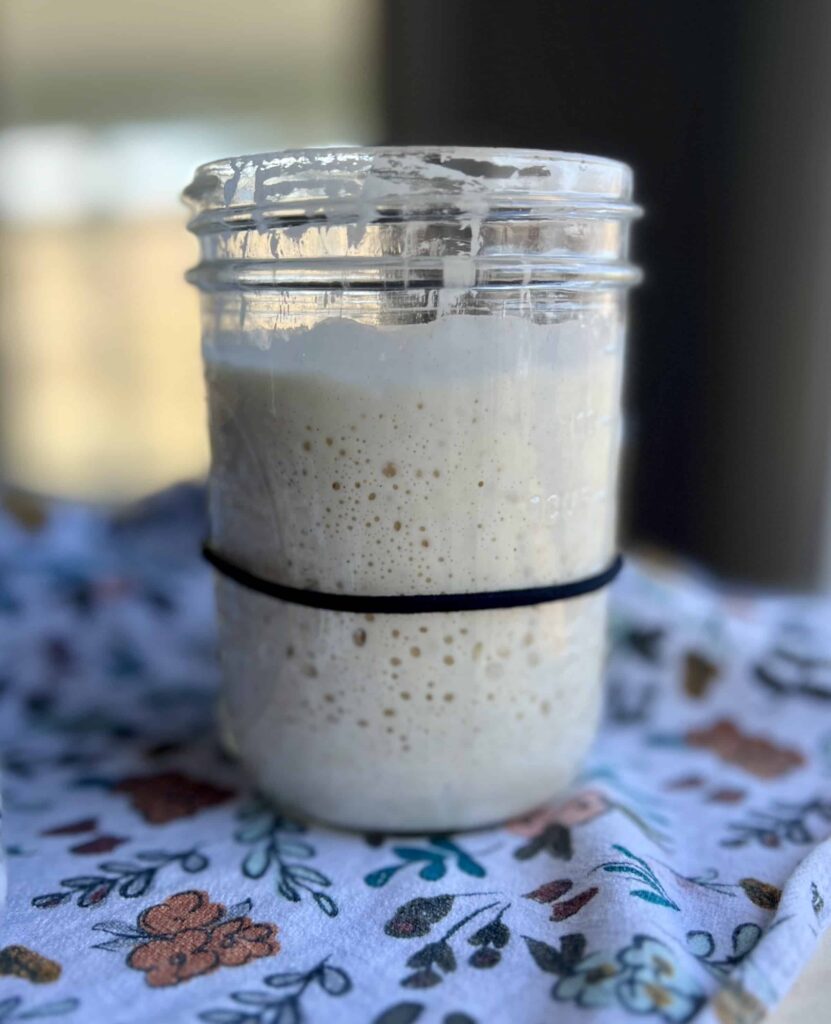
Mixing the Levain
My kids love sourdough bread, but they prefer a more mild than tangy version. In order to achieve this balance, I do a couple things when mixing a levain:
- Use sourdough starter that is just ripe in the fermentation cycle. The starter should just be reaching the height of its cycle when you use it to mix the levain. If you wait until the starter begins to fall, the loaf will be a little more “tangy.”
- Mix a sweet levain. I add a little sugar to the levain which helps counterbalance the acetic acid in the sourdough.
- Use a lot of levain in the dough. This actually helps the dough ferment faster, which will make the loaf a little less sour.
- I use a 1:1:1 weight ratio (1 part starter, 1 part flour, 1 part water) in this levain. This mixture will be ready to use in about 3-4 hours. A quick daytime levain ensures that I catch the levain when it is bubbly and has just risen to its height. Alternatively you could make the levain overnight with a 1:10:10 ratio (20 grams starter, 200 grams flour, 200 grams water, 30 grams sugar).


Mixing the Dough
To the bowl of a stand mixer, add the ripe levain, honey, egg, warm water, coconut oil, salt and bread flour. Mix for about 10 minutes until the dough is tacky and strong. Remove dough to a bowl or container. Cover with a plastic shower cap (the best tip!) or a kitchen towel and place in a warm place (75-80 degrees Fahrenheit) for bulk fermentation.
Pro Tip: The temperature of the water can have an effect on how quickly the sourdough ferments. If you are baking this bread in the summer, you will want to use cooler water to balance out the warmer ambient temperature in your kitchen. If you bake during the winter, a warmer water (nothing over 98 degrees–temperature of baby’s bath) can help increase the activity and fermentation process of the natural yeast.
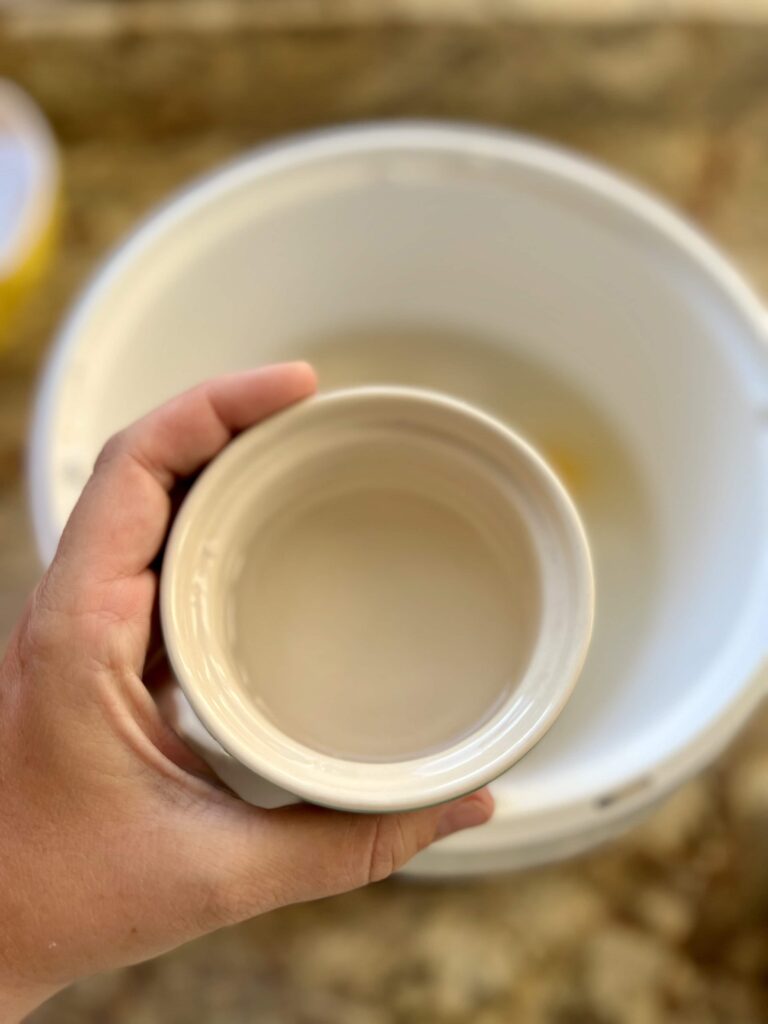

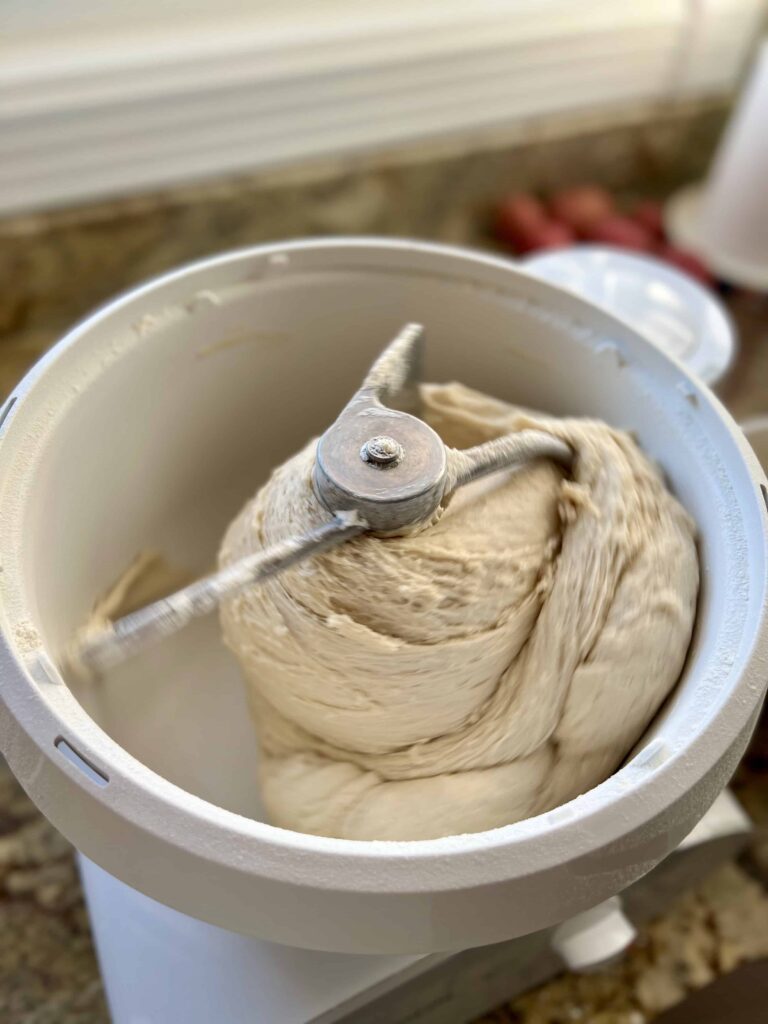
Bulk Fermentation
The total bulk fermentation time should be about 4 hours, with the dough’s internal temperature staying around 78-80 degrees Fahrenheit throughout the bulk rise. You are looking for the dough to almost double in size before proceeding to shaping the dough. During the first hour and a half of bulk fermentation, perform three sets of stretch and folds every half hour. This helps give structure to the dough and will make for a better finished loaf of bread.
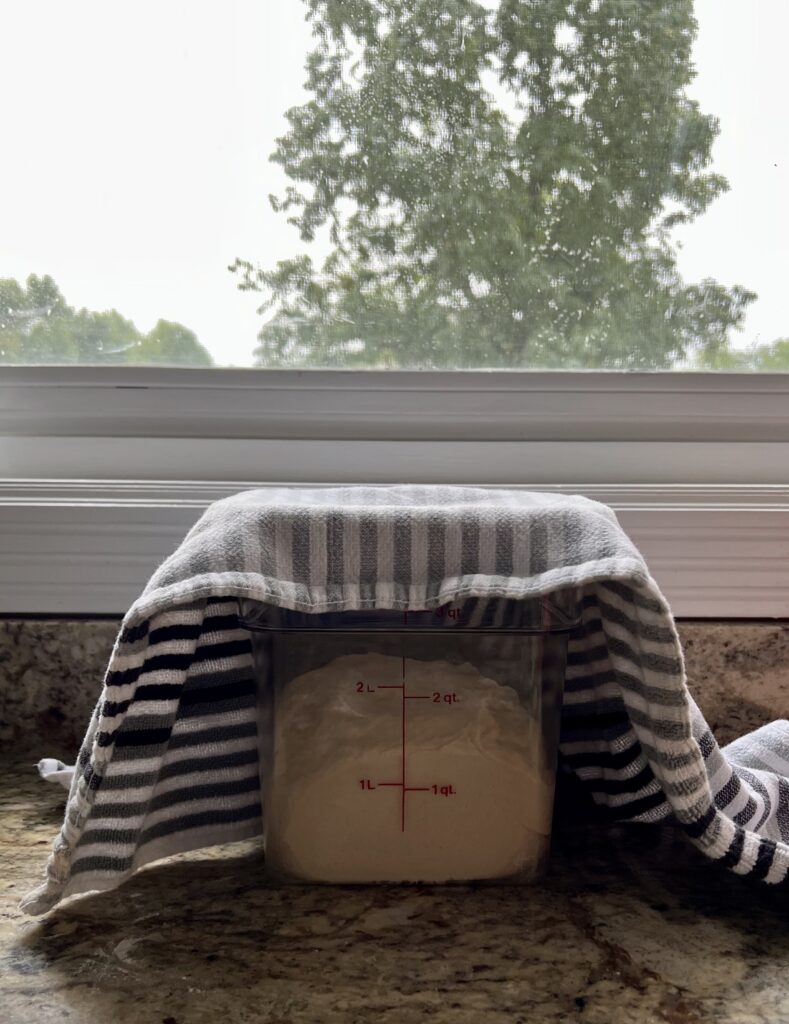
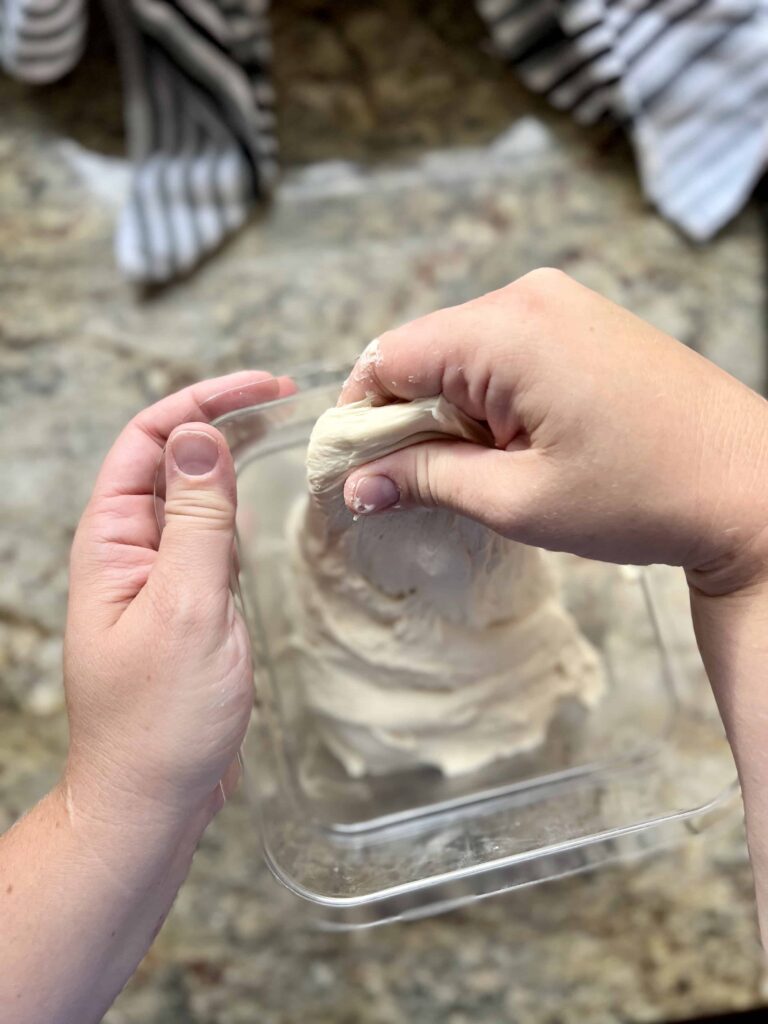
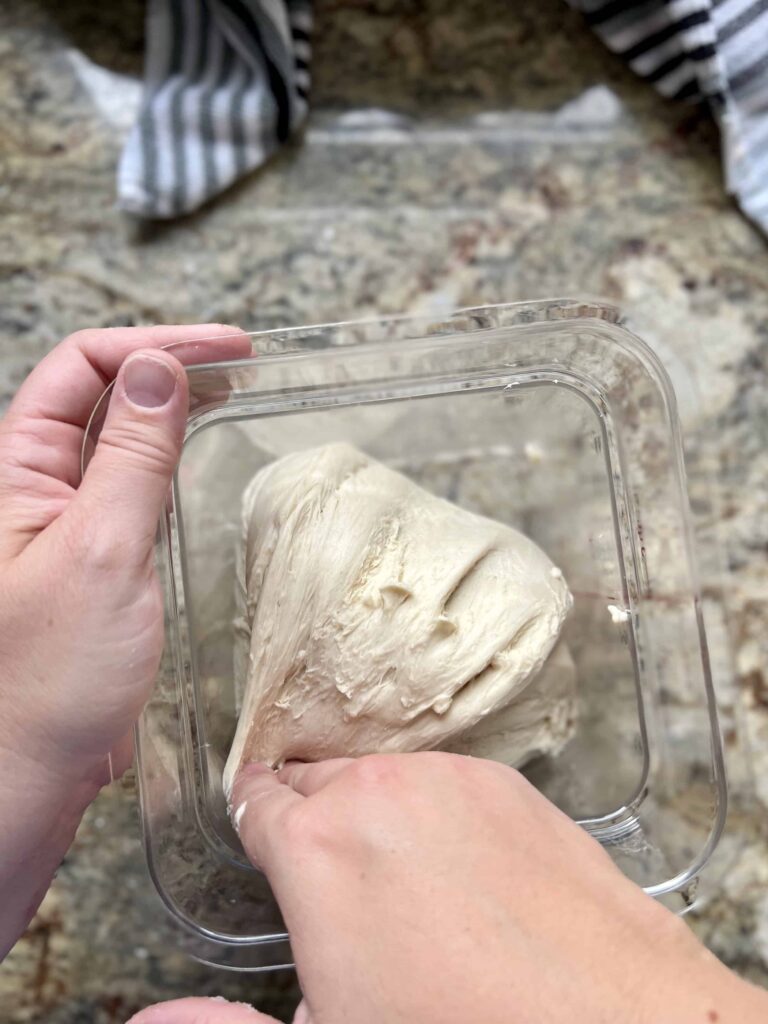
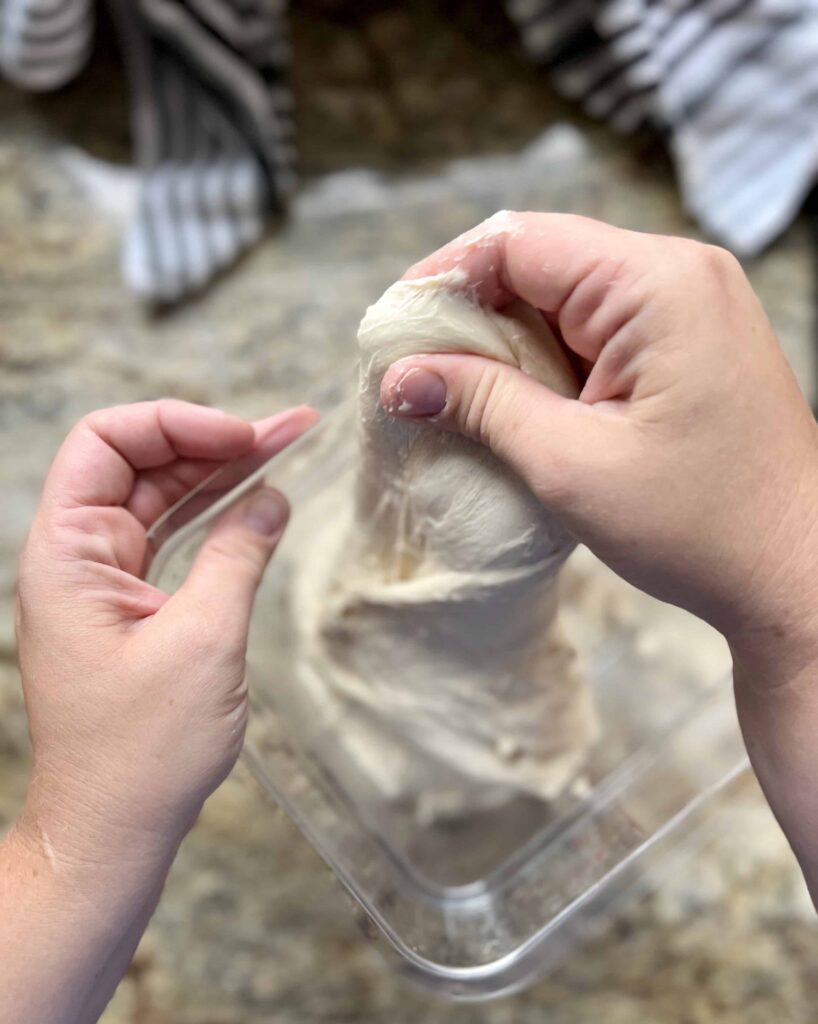
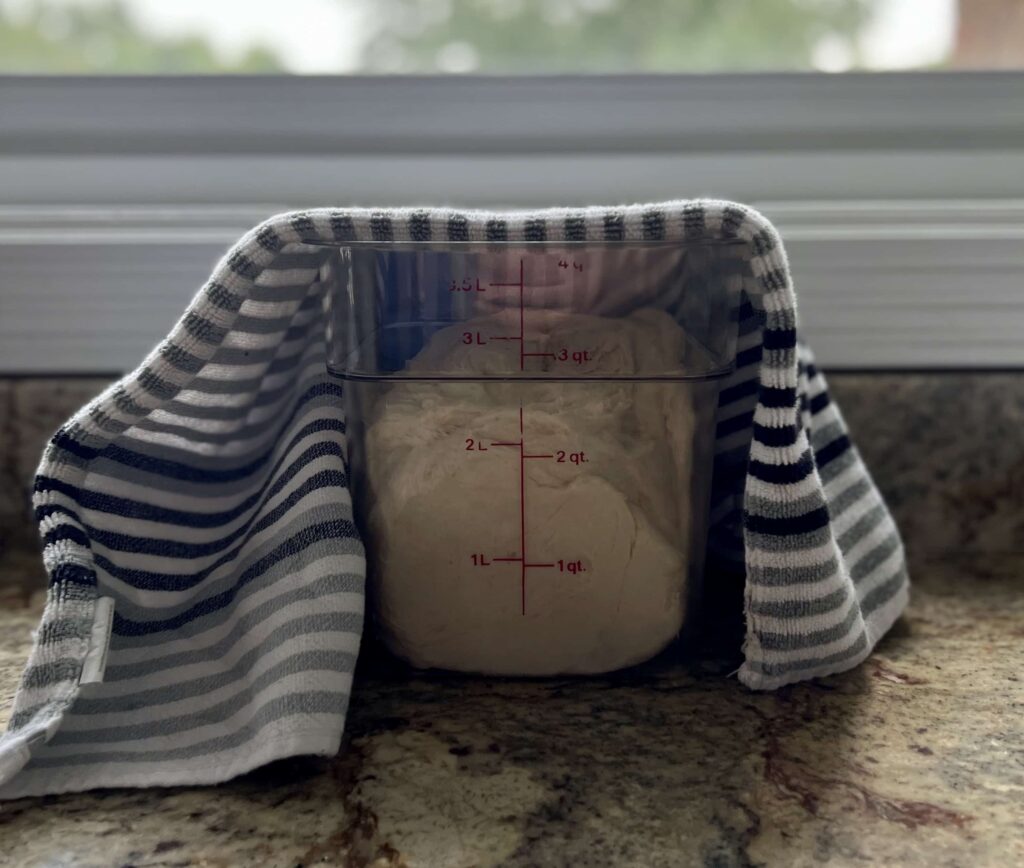
Shaping Soft Sourdough Sandwich Bread
Prepare two loaf pans. Pat one of the portions out into a rectangle. Starting at the edge closest to you, roll up the dough. Take care to press in the dough at the seam after each roll and pinch the seam closed at the end. Pinch and round the ends of the dough just a bit to get a uniform loaf. Place in a greased 8.5-by-4.5 loaf pan and cover. Repeat with remaining portion of dough. You can watch a shaping video here.
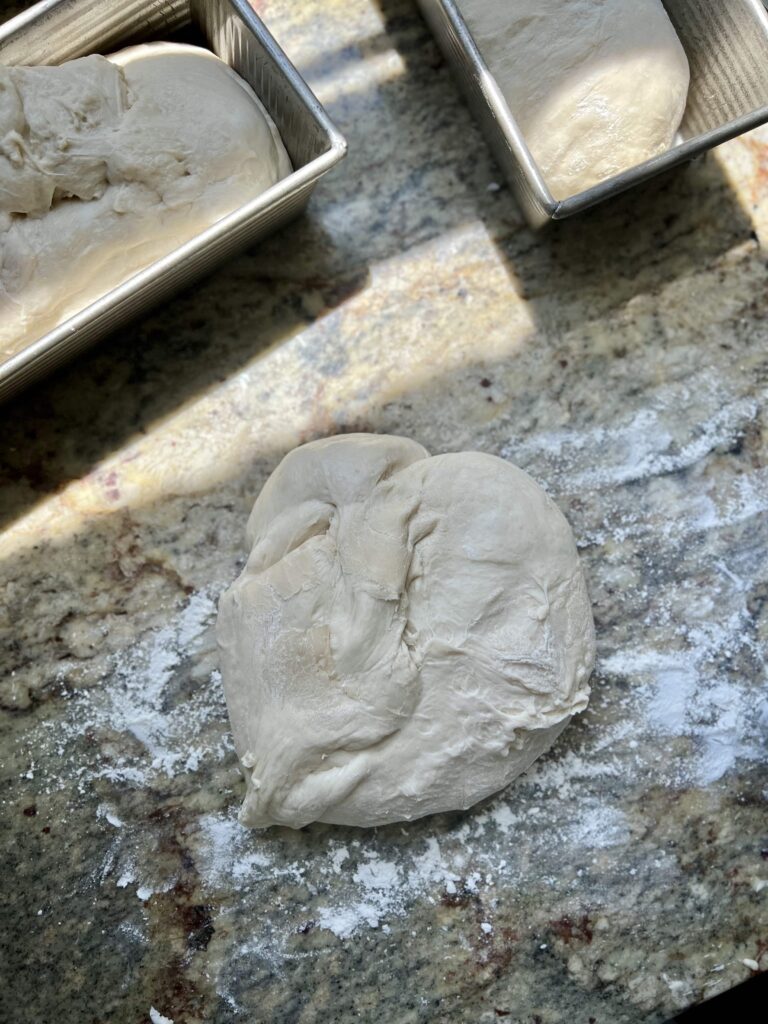
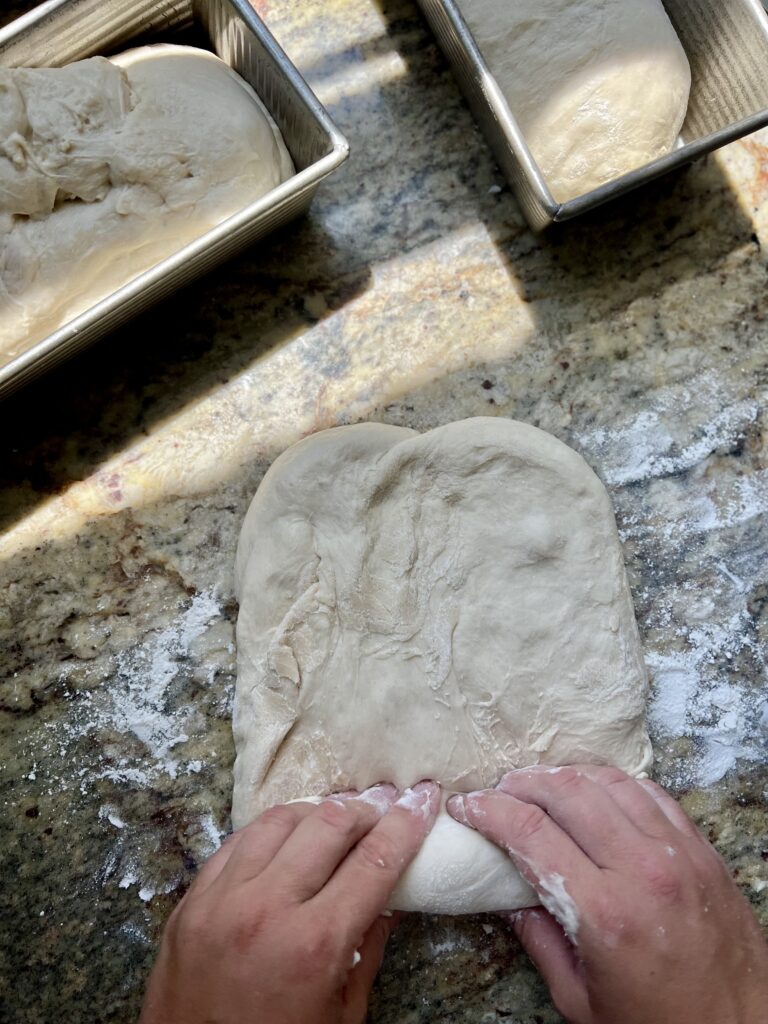
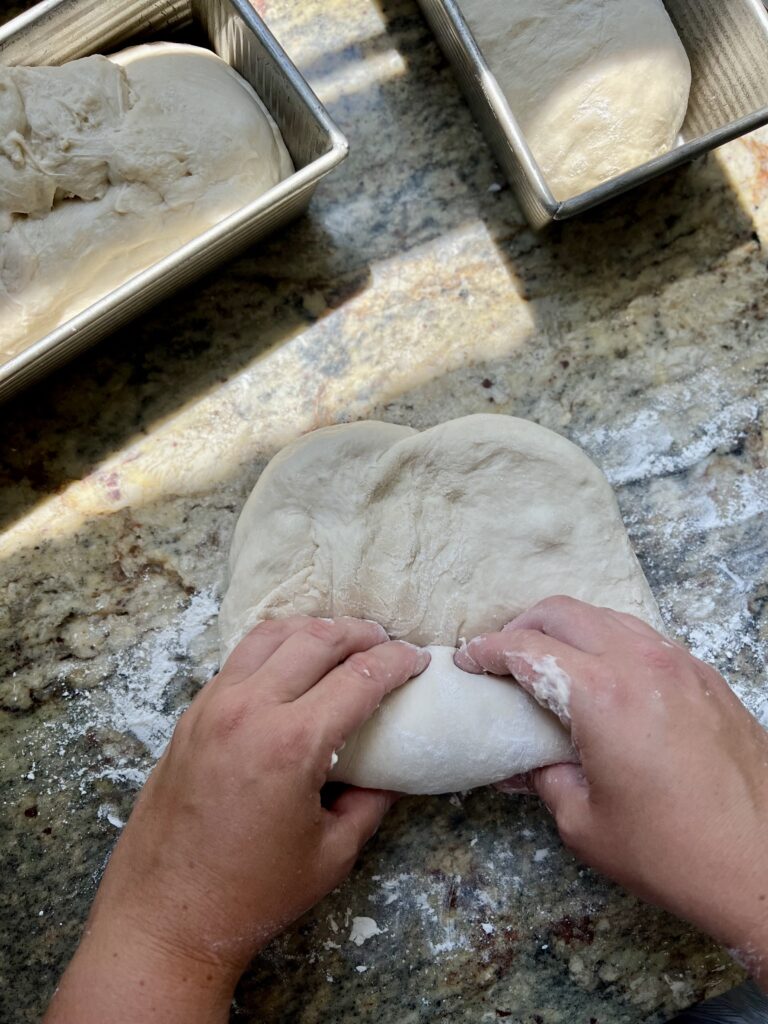
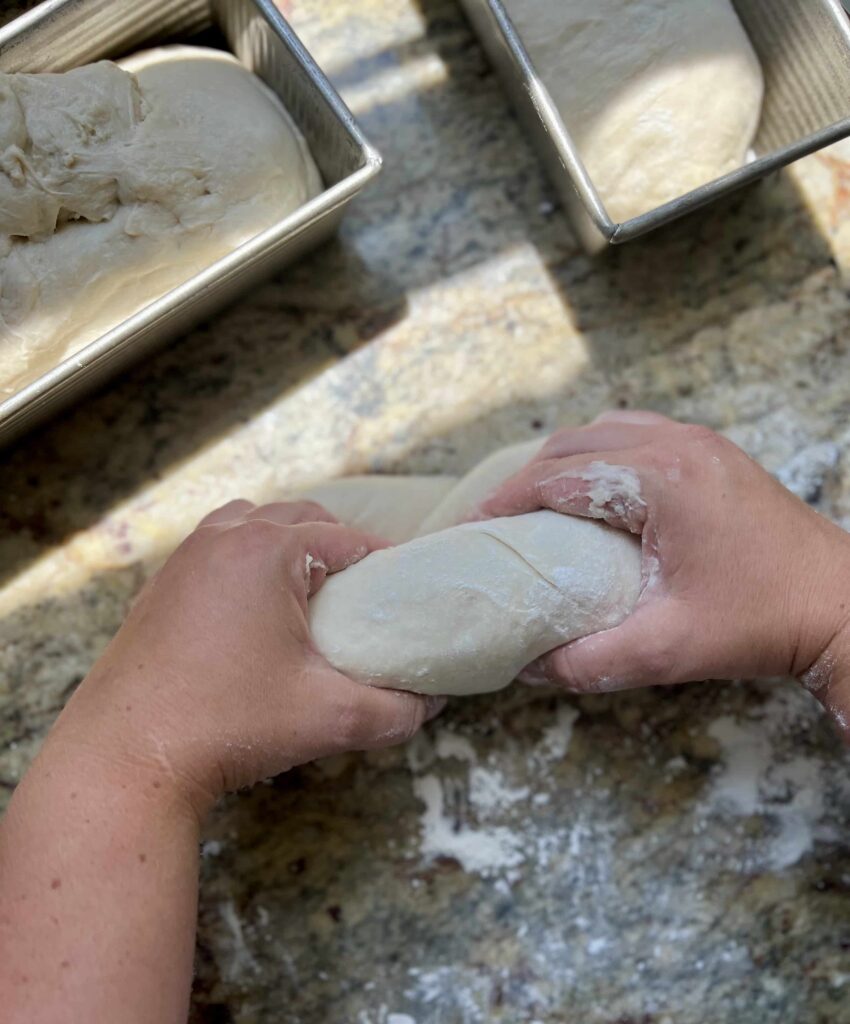
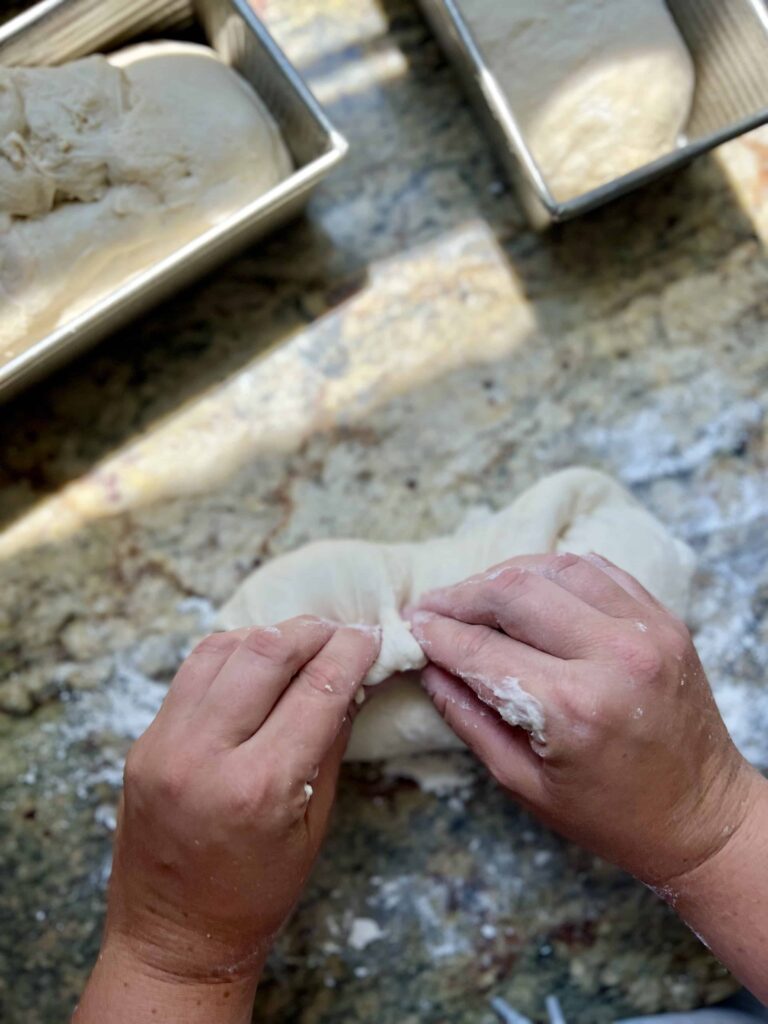


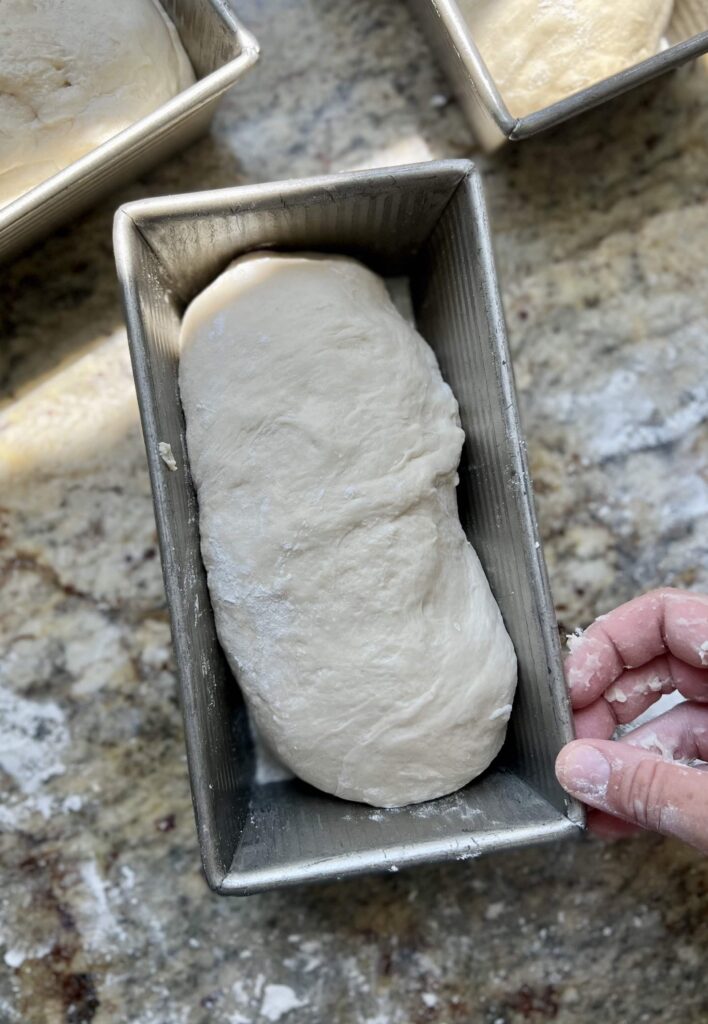
Proofing Sourdough Sandwich Bread
Proof the loaves of bread for about 4-8 hours at 78-80 degrees Fahrenheit. This bread can take A LONG time to rise. Temperature plays a big role in this. When I want to speed it up I like to proof my loaves in my oven with the light turned on (don’t turn on the oven). This gives the loaves warmth to rise. Before baking this bread, make sure that the sandwich bread has risen up over the bread tin AND has filled out the tin. It may take much longer for your loaves to prove. This can depend a lot on temperature and how active your starter is. I’ve had bread that’s taken 4 hours to rise and loaves that have taken 8-10 hours. If you notice the bread is not rising, put it somewhere warmer to encourage a rise. I’ve found keeping the dough temperature around 85-90 degrees F will speed up the rising process. Gently press a finger into the dough and see if the dough springs back. If it springs back quickly, the bread needs to keep rising. If it springs back just a little, it’s time to bake.
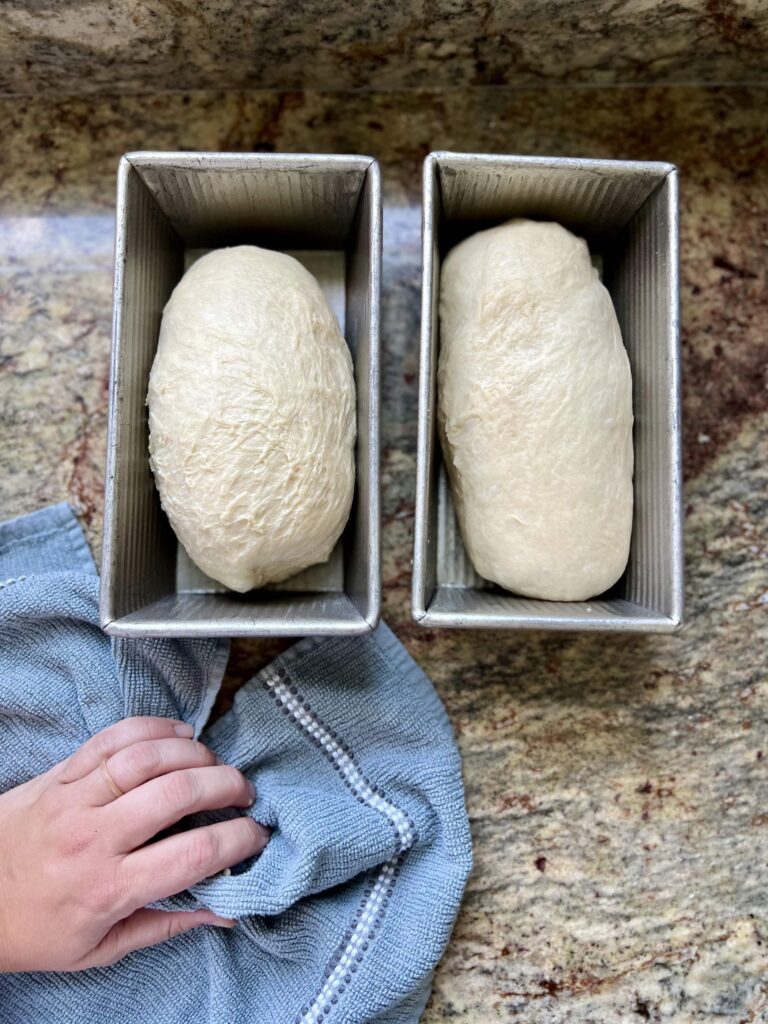
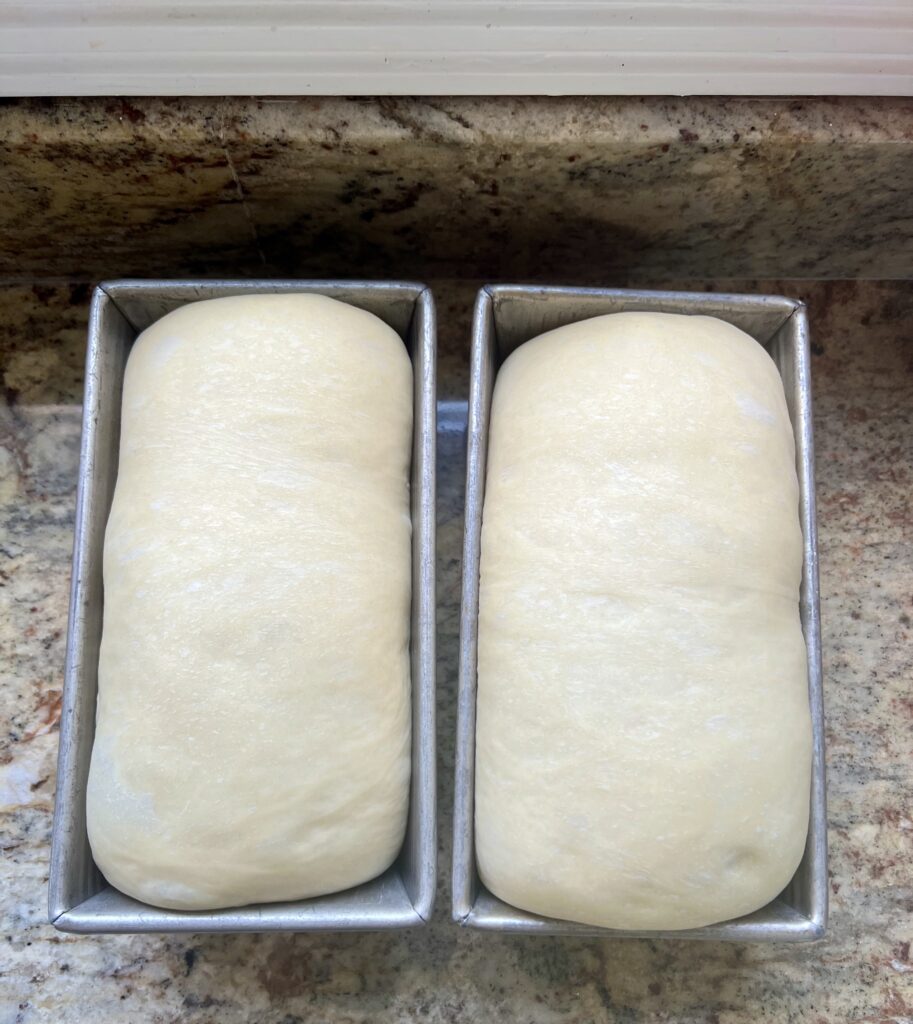

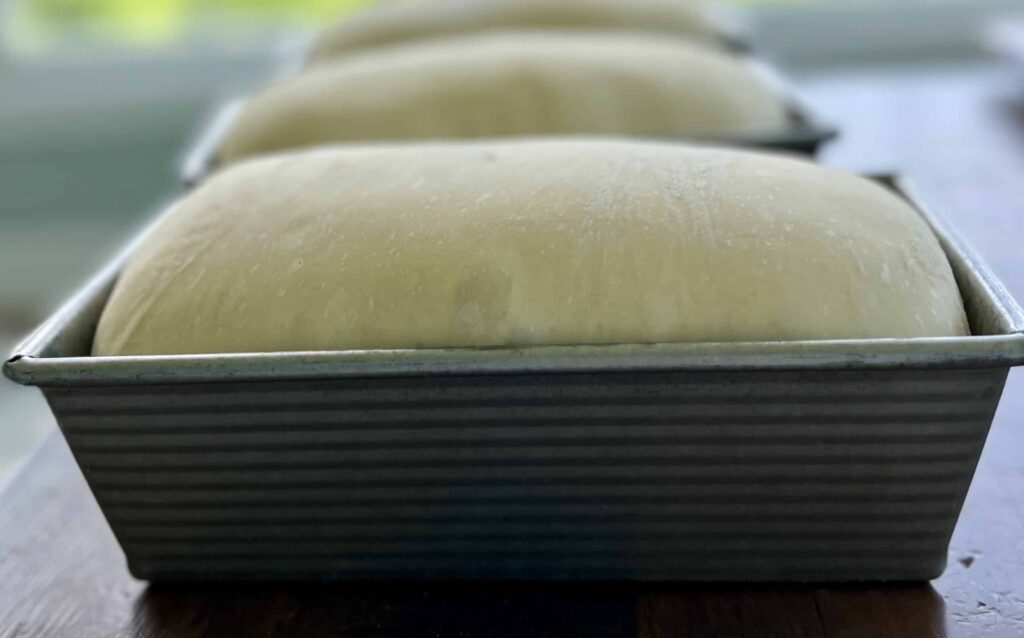
Baking Soft Sourdough Sandwich Bread
Bake sandwich loaves at 350 degrees Fahrenheit for 40 minutes. Top the hot loaves with melted butter. After about 5 minutes, gently release them from the pans. Allow the loaves to cool completely before slicing and enjoy!

Frequently Asked Questions
Let your sandwich loaves cool completely. Once cooled, turn them on their side and slice them. Store in a bread bag on the counter for 48 hours or stick them in your freezer. When you want a loaf of bread, pull it out and let it thaw before eating. I also like taking the frozen slices and toasting them individually as needed.
Yes. I love adding cinnamon chips for a delicious cinnamon bread. I also like adding garlic and grated parmesan into the bread dough while mixing for a savory bread.
Unfortunately it sounds like your sourdough didn’t rise enough. This can be so disappointing. You want to make sure the sourdough bread rises above the loaf pan before baking. Use the poke test: poke your finger into the bread gently. If the bread springs back with no indentation, it needs to rise more. If it leaves a small indentation and doesn’t spring back, it’s time to bake the bread. I’ve experienced “gummy” sourdough bread when I didn’t let my dough rise properly.
Most likely this is a temperature or sourdough starter issue. Make sure that the temperature of the dough is between 78-80 degrees F while it’s rising. You may also need to proof this dough in a proofing box or oven with the light on if your kitchen is cold. Another issue could have been your sourdough starter: was it rising and falling predictably before you made the bread? Did you take starter at its peak ripeness to make the levain? Did you use the levain at the peak ripeness (when it has the most active yeast in it)?
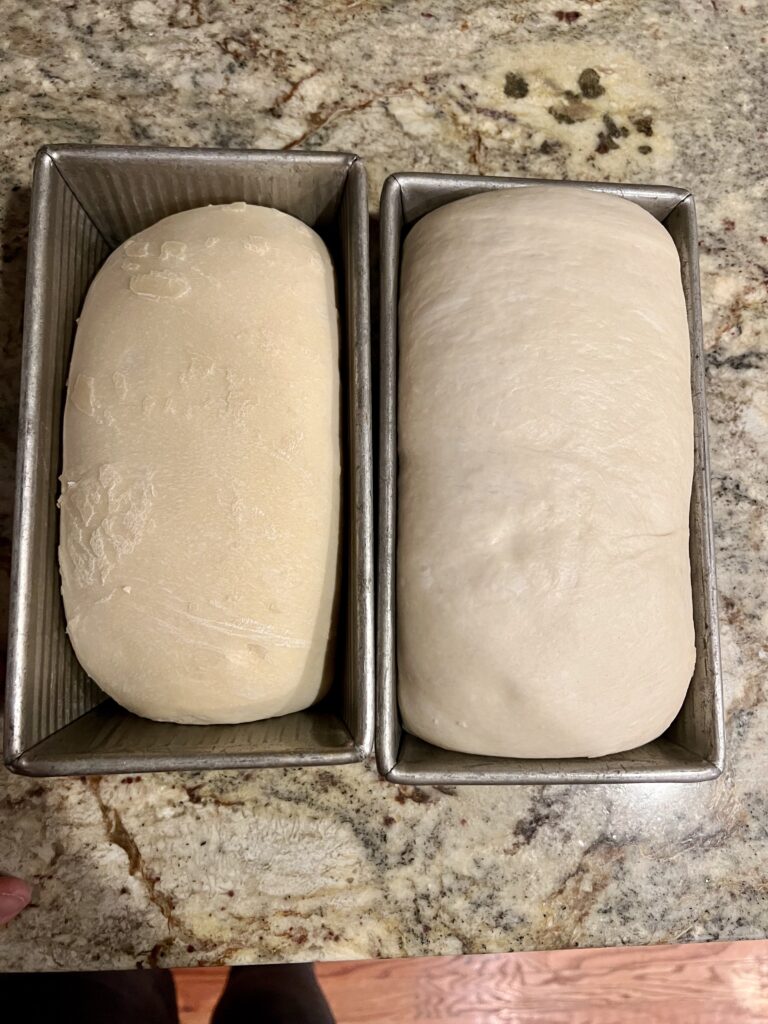
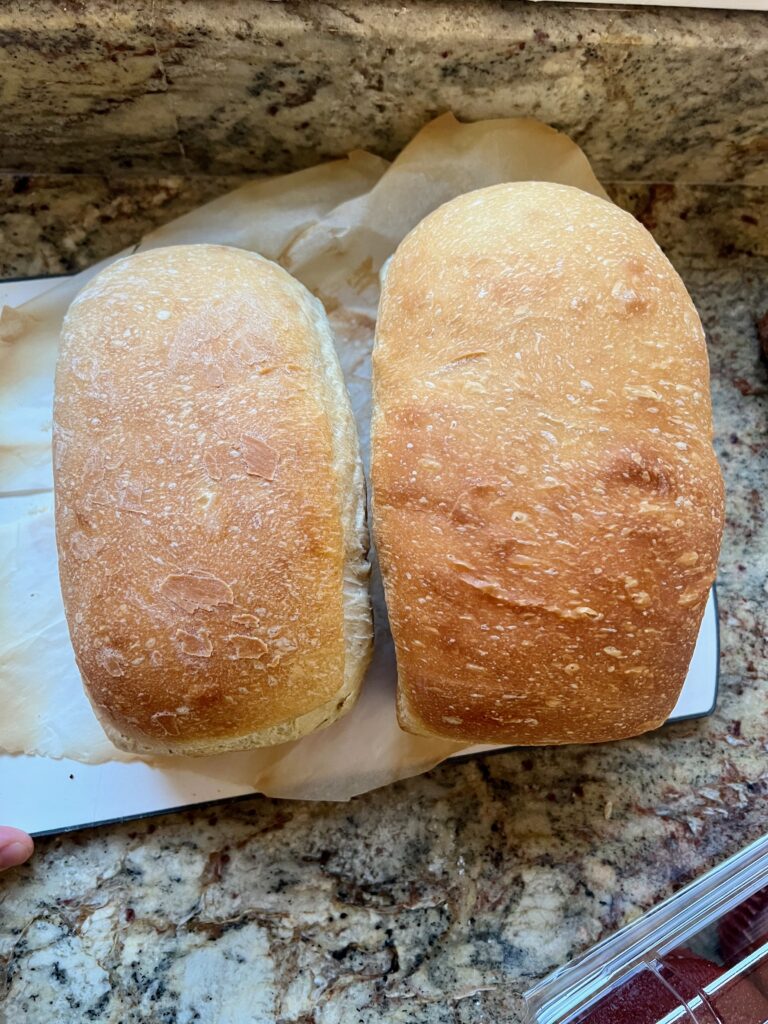
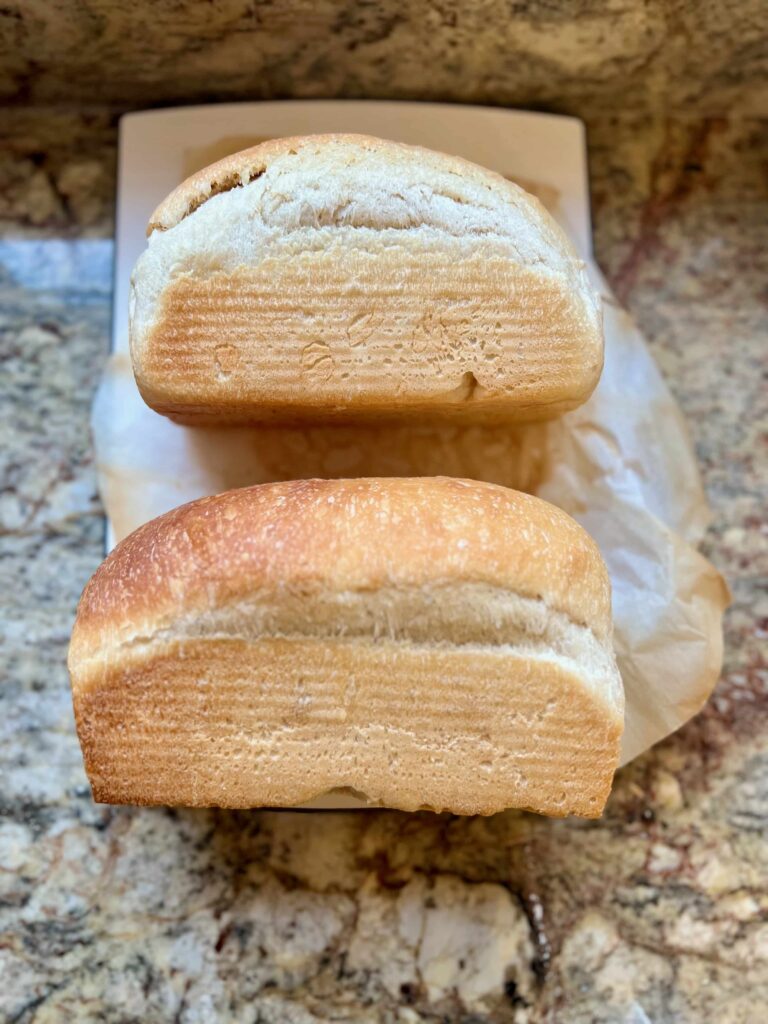

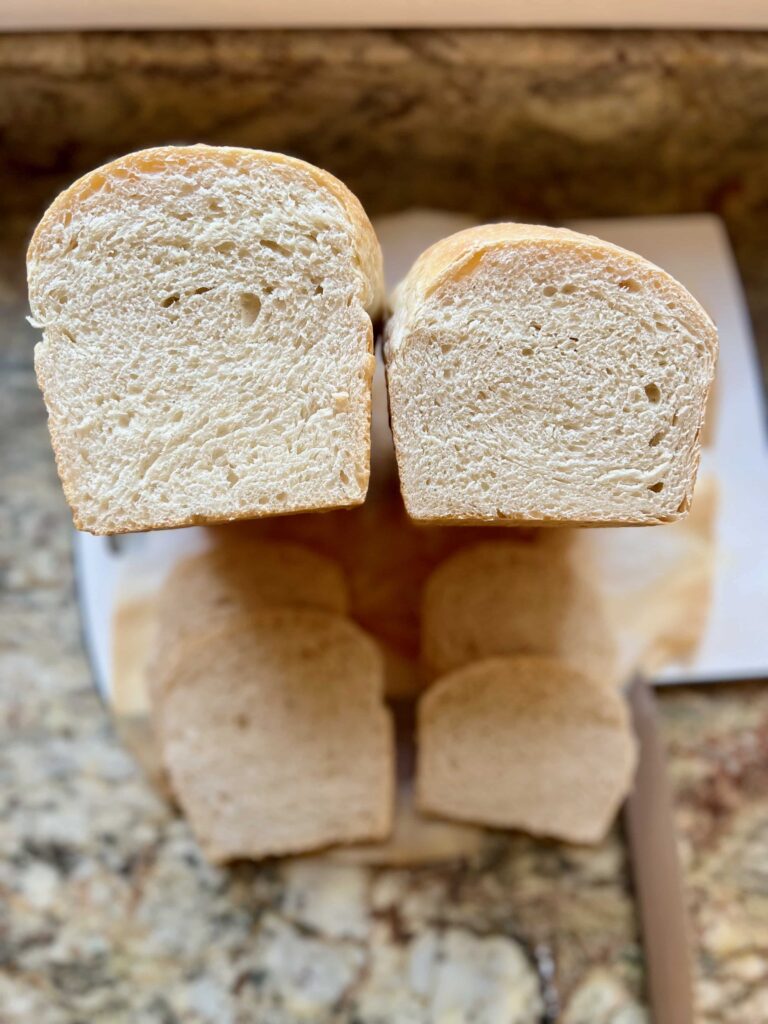
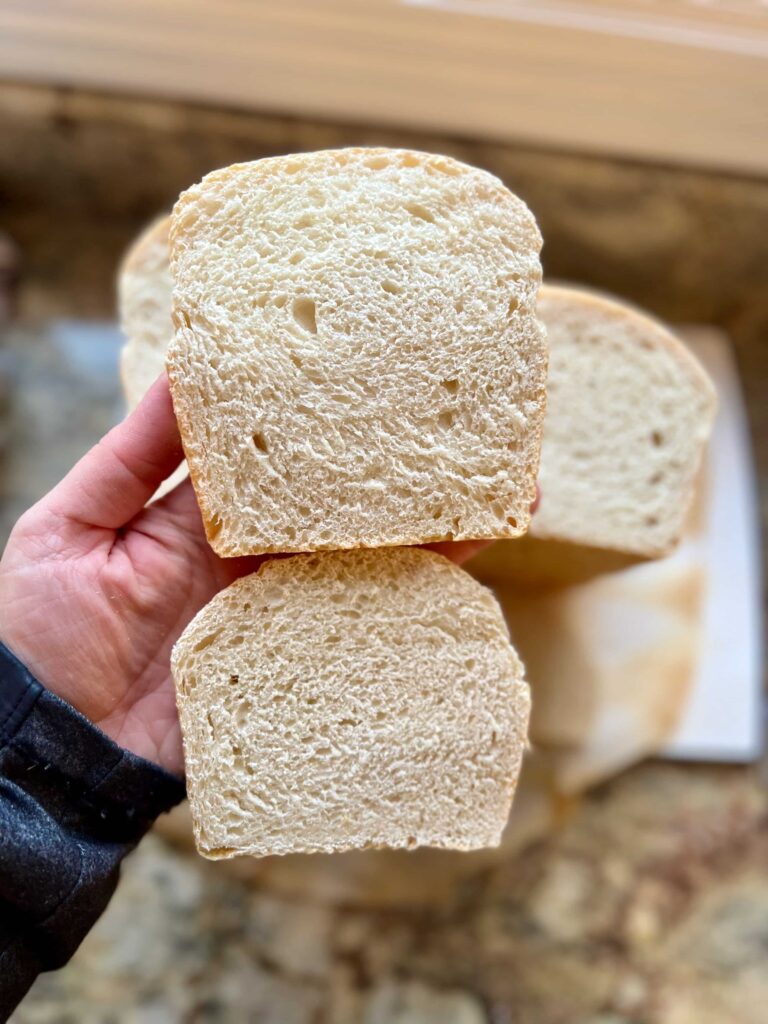

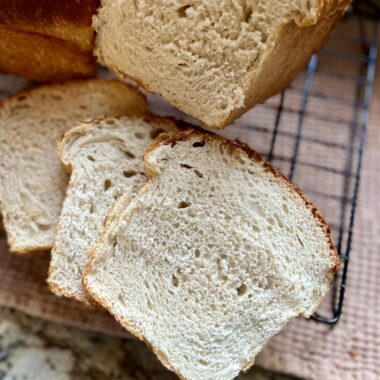
Soft Sourdough Sandwich Bread
Ingredients
Levain
- 140 grams sourdough starter bubbly and active, see recipe notes
- 140 grams all purpose flour
- 140 grams water see recipe notes
- 30 grams granulated sugar
Sourdough Sandwich Bread
- 400 grams levain about 1 3/4 cup
- 330 grams water see recipe notes, about 1 1/3 cups
- 160 grams honey about 1/2 cup
- 1 large egg about 50 grams
- 50 grams coconut oil melted, or any neutral flavored oil, about 1/4 cup
- 20 grams salt about 2 Tablespoons
- 950 grams bread flour about 6-7 cups, see recipe notes
Instructions
Levain (1:1:1, ready in 3-4 hours at 78ºF)
- Make the levain about 3-4 hours before mixing the dough.
- Take the temperature of your flour and sourdough starter. If the temperature of the ingredients are significantly below 78 degrees, use warm water (around 90 degrees) to mix the levain. If they are above 78 degrees, use room temperature water or cold water depending on how warm the ingredients are. Maintaining the temperature of around 78-80 degrees throughout the process will produce better results.
- Weigh 140 grams of active sourdough starter, 140 grams all purpose flour, 140 grams water and 30 grams of sugar. Mix together until a thick batter forms. Cover lightly and set in a warm (78 degrees) place to ferment for about 3-4 hours until bubbly, doubled in size, active and strong.
Sourdough Sandwich Bread
- Mix: To the bowl of a stand mixer, add the ripe levain, water, honey, salt, egg, coconut oil and most of the flour. I like to reserve a little of the flour (a little less than a cup) and add it in as needed. Knead for 10-15 minutes until dough passes the windowpane test. The dough should pull away from the sides of the bowl or gather all together as it kneads. It will feel tacky to the touch, but should not be overly sticky. If it is very sticky, add a little bit more flour 10-20 grams at a time until it feels tacky and workable. This dough can also be kneaded about 10-20 minutes by hand.
- Begin Bulk Fermentation: Transfer the dough to a large container and cover with a plastic shower cap (the best!) or kitchen towel. Let rest for 30 minutes. After the 30 minutes, perform a series of 3 stretch-and-folds with a half hour between each set. If you don't have time for all the stretch and folds, I've recently had success doing one or two or even leaving them out completely.
- Stretch and Fold 1: Starting on one side of the bowl, reach down and grab the bottom of the dough. Pull it up and stretch it over the top of the dough. Turn the bowl 1/4 turn and repeat the whole process 3-4 times. Cover the dough and let rest.Stretch and Fold 2: After 30 minutes, repeat the stretch and fold process, stretching and folding about 3-4 times. Notice how the dough is strengthening and starting to rise. Stretch and Fold 3: After 30 minutes, repeat the stretch and fold process for the last time, stretching and folding about 3-4 times. Cover the dough and finish the bulk rise.
- Bulk Rise: Let the dough rise until puffy and almost doubled in size for 2.5 hours (a lot of this will depend on the temperature of your dough–about 78-80 degrees is the sweet spot). The dough should rise and almost double in size during this time. If it does not, take the temperature of the dough and make sure it is warm enough. Let it continue rising in a warm spot until about doubled in size. At this point you can also stick the dough in the refrigerator after a couple of hours for a long cold bulk rise. See recipe notes.
- Divid and Shape: Turn the dough out onto the counter. Separate into two equal portions of dough. Pat one of the portions out into a rectangle. Starting at the edge closest to you, roll up the dough. Take care to press in the dough at the seam after each roll and pinch the seam closed at the end. Pinch and round the ends of the dough just a bit to get a uniform loaf. Place in a greased 8.5-by-4.5 loaf pan and cover. Repeat with remaining portion of dough. You can watch a shaping video here.
- Rise: Let the bread rise in the pan for 4-8 hours until the dough has risen over the edge of the loaf pan. Depending on time of year, temperature and how active your yeast is, the rise could be shorter or much longer. If you notice no change and no rise, put the bread in a warmer place (oven with a light on or bread proofer). Press in gently on the dough with a finger. If the dough springs back immediately, it needs a little more time to rise. If it leaves a little indentation and springs back just a little bit, it is ready to bake.
- Bake: Pre-heat oven to 350 degrees. Bake loaves of bread for 40 minutes. Spread melted butter on the tops of the loaves if desired. Let bread cool completely before slicing for sandwiches. Enjoy!

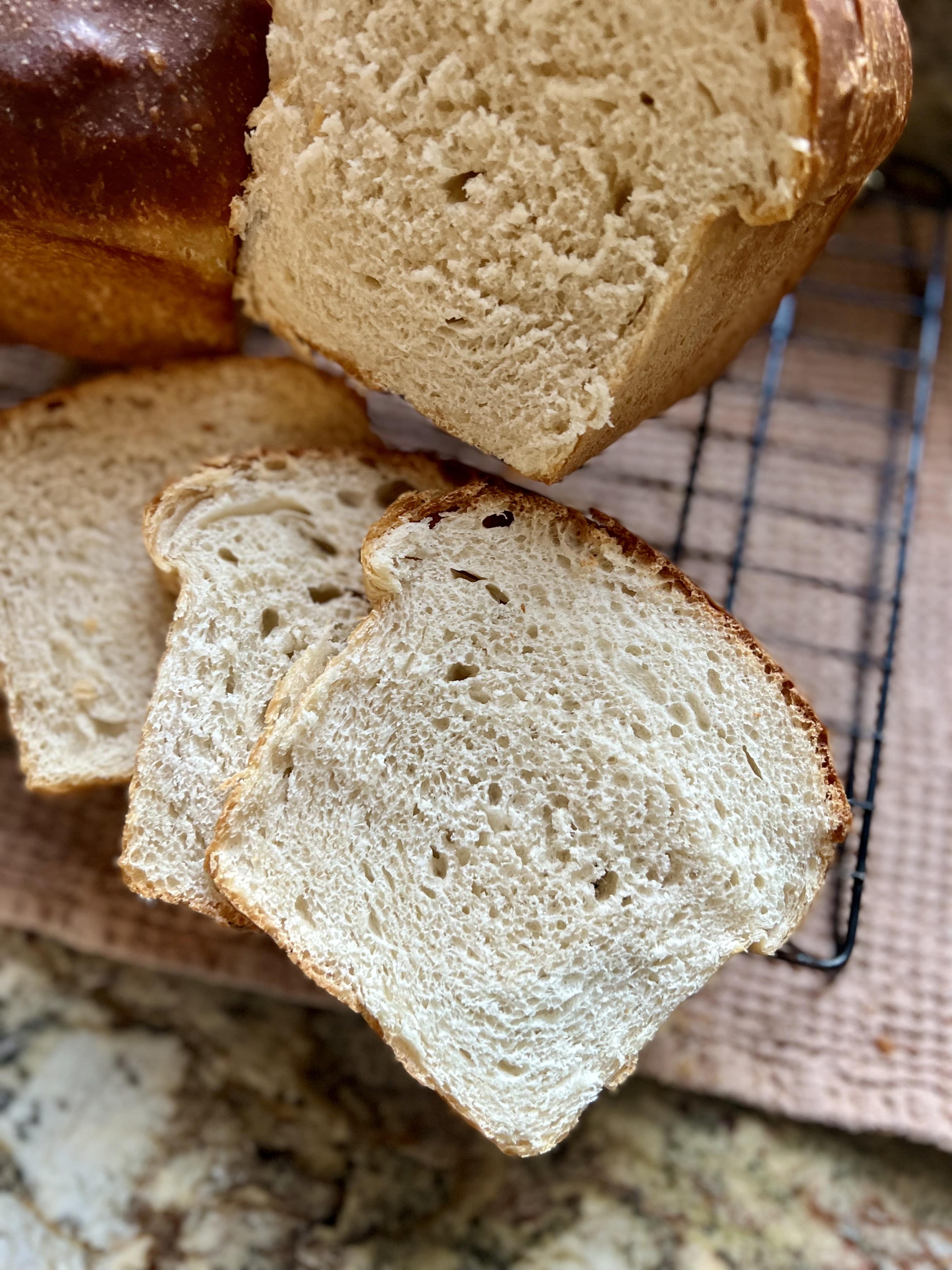
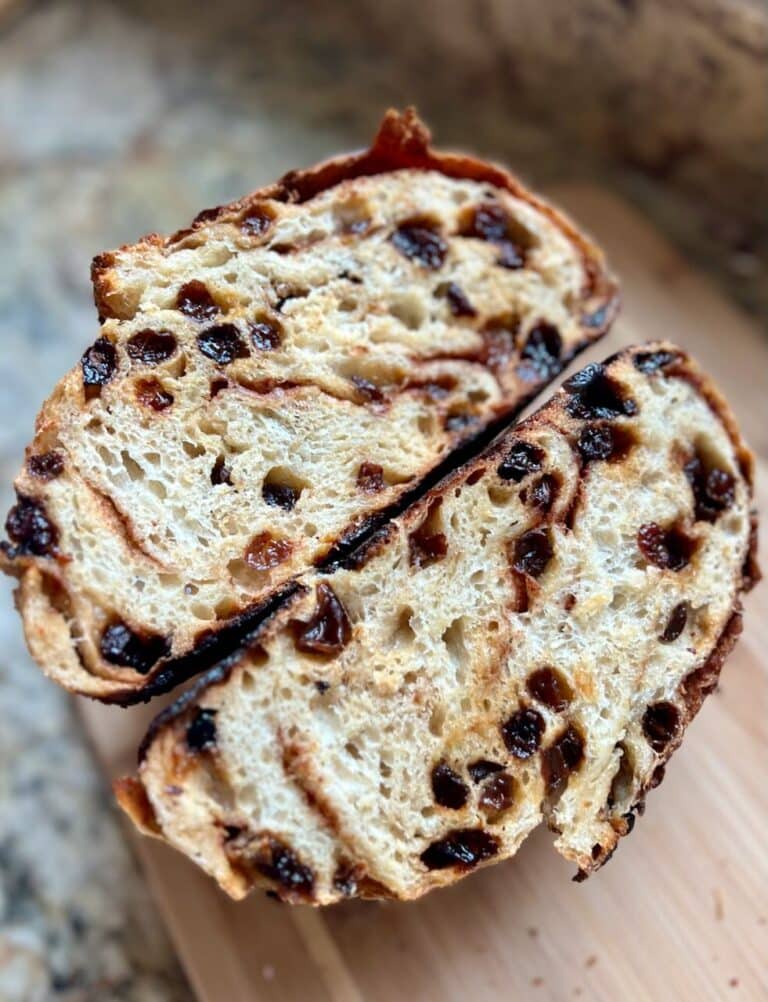

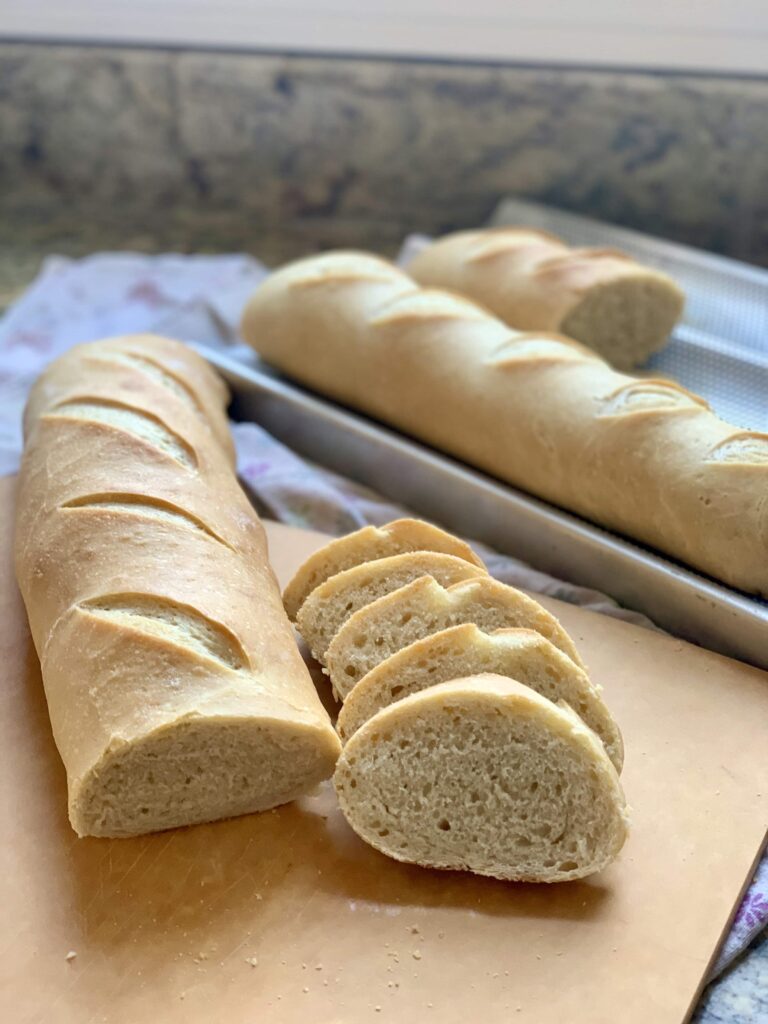



The most delicious and amazing sourdough sandwich bread. I thank you so much for sharing your recipe with us. This is a game changer.!!!!!!
So glad you love this bread! Thanks for sharing.